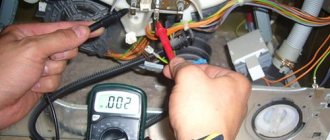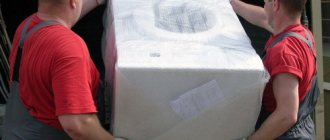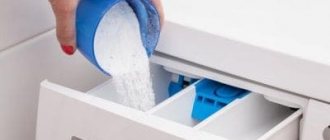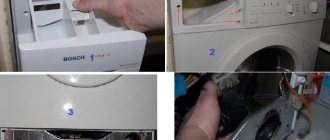Transportation regulations? It is no coincidence that new washing machines require the use of packaging for these purposes, reinforced with shock-absorbing gaskets that guarantee complete safety of the contents of the components. The mechanism of the device is sensitive to accidental shock, vibration, incorrect orientation in space, contact with moisture, etc., therefore, transportation of a device that has already been used must also be done correctly, preferably in the original box. People wonder whether it is possible to transport a washing machine while lying in the car.
Preparation for transportation
The preparatory stage of transporting SMA in a passenger car must necessarily include the following sequence of actions:
- checking the internal compartments of the device (hoses, pipes, pumps) for the presence of water in them, which can remain there for a long period after washing;
- disconnecting the drain filter and immersing the outlet of the part into a container installed below the level of the tray of the washing unit and designed to drain stagnant liquid;
- drying the internal components of the washing machine by opening the valves for a couple of hours.
Even a small amount of moisture remaining inside the device when the case is tilted can damage the electronics of the device.
Drum fixation
Experts strongly advise transporting an automatic washing machine only after first securing its drum. Poor quality of the road surface causes vibrations and pitching, as a result of which this part can cause damage to the insides of the household appliance.
Any model of washing machine comes with shipping bolts that can be used to securely secure the drum. Each transport bolt must be tightly screwed onto the rear wall of the SMA housing.
If the factory set of fasteners is lost, and the range of the nearest household appliance stores does not include this type of component, the drum can be fixed without transportation bolts.
After removing the horizontal cover of the SMA, it is necessary to place a foam gasket in the space between the drum and the inner surface of the device body. After checking the reliability of fixation of this part, the machine is almost ready for transportation.
Package
At the packaging stage, it is important to adhere to the following procedure:
- carefully twisting, wrapping in polyethylene and attaching the power cord and hose to the body using improvised means;
- fixing the detergent dispenser with adhesive tape or removing it to prevent the component from opening and falling out during transportation;
- covering the body of the washing device with several layers of protective film (if this is not available, it is necessary to take care of the external protection of the machine with blankets and materials that can act as a shock absorber in the event of a possible impact).
The packaging materials are secured on the outside with twine or tape.
Thorough preparation is the basis for safe transportation
When purchasing a new washing machine, there are no problems with transportation. The equipment is reliably protected by the original packaging, so when loading and moving the car you don’t have to worry about the integrity of the unit. Difficulties have to be encountered when transporting equipment that has been in use. The owner has long ago gotten rid of the box in which the machine was sold, and the shipping bolts are irretrievably lost. In order for the equipment to reach its destination without damage, you will have to carefully prepare for the trip. The procedure is as follows:
- The washing machine should be disconnected from the power supply and the water supply hoses should be disconnected.
- The equipment must be thoroughly dried. Lower the water drain hose below the pan of the machine - this will help remove the remaining liquid. Leave the valves open for a while to allow the moisture to completely evaporate.
- Carefully twist the wires and hoses and wrap them in plastic. Use tape to secure the powder compartment.
Offers its assistance in transporting the washing machine. A specially equipped truck and a team of experienced movers are provided to clients. The team knows all the intricacies of handling equipment, so transportation will take place as quickly and safely as possible. The company has set affordable prices for services. Entrust the solution to the problem to professionals - do not risk your “assistant”.
Back to Contents
How to transport it correctly
After all fragile elements of the automatic washing device are protected from factors that could harm the operation of the device during transportation, you need to study the list of recommendations for the safe transportation of AGRs:
- when loading, the washing machine may tilt slightly towards its rear panel;
- It is not permitted to transport such electrical appliances in a horizontal position;
- the optimal vehicle option for transporting a washing unit is a small truck, the use of which minimizes the risk of damage to the body and internal components of the AGR as a result of falls and impacts;
- the washing appliance can be loaded in such a way that the machine first lies on its side and then assumes a vertical position;
- a layer of rags or other soft materials should be laid under the transported SMA, which will act as additional shock absorption when the vehicle moves;
- a passenger car (its interior or luggage compartment) is not intended for transporting such fragile large items: such a method of transportation is fraught with damage.
How to remove shipping bolts?
Bolts are simply necessary for transporting the washing machine, but when used for its intended purpose, they will only get in the way. Therefore, before starting the first wash of clothes, they must be unscrewed.
This is no less important than the correct installation of this type of household appliance and its careful operation
We recommend that you pay attention in advance to the fact that if your machine breaks down because you forgot to remove the bolts, then this breakdown will be solely on your conscience. And not a single service center will repair your new but already broken car under warranty.
That is, in order for it to be repaired, you will have to pay.
Finding the shipping bolts in your washing machine is very easy. They are located on the back wall of the case. Usually there are three to four of them there. There are brands of machines that use metal pins instead. This is found in household appliances produced under the Millet and Gorenie brand. It is rare, but it still happens that some special models have a specific bolt arrangement. For example, on one machine they were found under the upper part of the body.
In order to unscrew the bolts you will need a regular wrench of the required size (usually from 10 to 14 mm). If you don't have a key, you can use pliers. The shipping pins are removed using pliers. In order to get them out, you need to grab them with pliers and turn them to the side a quarter turn. They will then be freely removed from the housing.
The holes left by the bolts should be plugged using plastic plugs. These plugs are included with the kit. The point of having plugs is more decorative than practical. Although it is possible that their presence may slightly reduce the noise produced by the machine during washing.
Is it possible to transport a washing machine on its side?
The only correct and safe way to transport SMA involves the use of vehicles specially designed for cargo transportation in Moscow and large cities.
The internal space of their vans will allow you to transport the electrical appliance in an upright position. But the question arises: is it possible to transport a washing machine lying down? This position of the electrical appliance during transportation can only be forced when a passenger car is chosen as the vehicle.
Transporting an electrical device in a horizontal position will not lead to damage to the internal mechanisms if its body is laid on its side (on the rear panel) and securely fixed on the surface of the luggage compartment, roof or interior of the car, covered with a soft layer of shock-absorbing material. The machine should be turned sideways in the direction of travel.
Protect it like the apple of your eye, or How to securely fix the drum?
The drum of a washing machine is one of the most important and fragile mechanisms. When hitting a bump, an unfixed structural element will damage other parts of household appliances. The unit is supplied with transport bolts from the factory. They are installed on the back of the machine and help securely fix the drum.
Such small details are often lost over time. Therefore, the question arises along the way: how to transport a washing machine without transport bolts? In such a situation, the drum is immobilized using available means. The work is quite easy:
- Unscrew the bolts and remove the top cover of the unit.
- Fill the space between the tank and the walls with unnecessary rags, foam rubber, and polystyrene foam.
- Check that the drum is stationary.
- Reinstall the top of the machine.
After completing this operation, you should start packing household appliances. It’s good if the factory box has been preserved, then the free areas inside are simply lined with polystyrene foam. But more often, owners throw away cardboard containers immediately after installing the washing machine. Knowing the packaging rules, you can maintain the presentation of the equipment even without the original box. The sharp corners of the washing machine are covered with cardboard and covered with tape. The product itself is wrapped in fabric and tied with ropes. The main task of the preparatory stage is to ensure reliable protection of the components of the equipment from vibrations that can damage it.
Back to Contents
What are the dangers of incorrect transportation?
Failure to comply with the rules for transporting household AGRs is fraught with violations that are incompatible with its further functionality. Improper transportation of the washing machine can lead to the following negative consequences:
- breakdown of the drain pump;
- the compartment for detergents falls out and the integrity of its body is damaged;
- occurrence of malfunctions in the control panel;
- short circuit of electronics due to contact of contacts and wiring with liquid;
- the formation of holes, cracks, kinks in pipes and hoses;
- shock absorber failure;
- rupture or bending of the power cord;
- the appearance of tears in the cuff.
Damage to external elements may also occur: the hatch or its hinges, the body (the appearance of chips as a result of strong impacts).
How to prepare
First you need to start preparing the washing machine for further transportation.
Shutdown
Experts recommend disconnecting the washing machine from all communications. Therefore, before transportation, the equipment is disconnected from power sources and disconnected from the sewage system. It is also disconnected in advance from the water pipes that are responsible for the flow of water.
If you do not disconnect all communications in advance, you may damage the sewer or water hoses when trying to transport the washing machine.
Removing water
Another action that is performed in advance is draining the remaining fluid from the system. Water often remains in the pump, pipes and hoses that are responsible for the flow or drainage of water.
Fixations of hoses, wires and hatch
Many people choose not to secure wires and hoses that may be attached to the washer. However, it is better to secure them in advance so that when carrying them they do not cling to anything or get tangled. They can be secured with tape to one of the walls or removed altogether.
Taping sharp corners and parts with tape
Any equipment has sharp corners, and the washing machine is no exception. The main danger of such corners is that they can scratch you and damage your limbs. Therefore, for safety reasons, it is better to carefully cover each sharp corner with a thick layer of tape.
Fixing the tank
Before transportation, the drum must be securely attached to prevent accidental damage.
How to Install Shipping Bolts
Most often, special transportation bolts are used to secure washing equipment tanks. These are the most suitable fasteners that manufacturers recommend using. These bolts are very easy to use. To fix the tank, simply insert each bolt into the drilled mounting holes located in the back of the machine.
How to transport without shipping bolts
Sometimes people do not have transportation fastenings and have to fix the drum with improvised means. First you need to unscrew the back panel of the structure and place things that can soften vibrations in the hole between the wall and the tank. Unnecessary rags, foam rubber or small pieces of foam are suitable for this.
Package
Before transportation, equipment must be packed so that it is not damaged on the road. Various materials can be used for packaging.
In factory
The best option for packaging equipment is to use the original box. In this case, you just need to place the washing machine inside the package and pack it carefully so that it does not dangle during transportation. The box must be carefully wrapped with tape so that it does not open on the road due to possible shaking.
Textile
People who purchased a machine more than five years ago rarely keep the boxes and therefore have to pack the equipment in other ways. Fabric materials are often used to completely wrap the structure. Fastening the fabric is carried out with ordinary tape or adhesive tape.
Corrugated cardboard
To pack the washer before transportation, you can use corrugated cardboard. Cardboard covers the side walls of the washing equipment, as well as its upper and lower parts. Cardboard sheets are fastened together with metal staples or tape.
Stretch film
Many people think that stretch film is only used for packaging small items, but this is not true. This material is also suitable for packaging washing machines.
The film is carefully wrapped around the equipment to protect its surface from mechanical damage.
What are the consequences of violating transportation rules?
Without studying the established rules, SMA owners quite often cause significant damage to the equipment during its transportation. Even a short trip of no more than fifteen minutes can result in complete failure of the device.
What can happen if transportation is disrupted:
- the power cord breaks,
- machine parts made of plastic material break,
- the rubber cuff of the loading hatch breaks,
- the hatch fastenings and its guides break off,
- shock absorbers fail,
- rubber components are torn - pipes, hoses,
- wires, contact groups are oxidized and short-circuited,
- The selector wheel on the control panel for setting programs breaks,
- the pump that drains the water loses its functionality,
- If you forget to fix the powder receiver, it can also be damaged.
Each of the breakdowns is eliminated, except for the damaged housing part or the complete loss of functionality of the electrical unit. Connecting the machine for testing is permitted after it has been completely unpacked and the bolts securing the drum have been removed. It is likely that they may be needed someday. The best storage option is in a plastic bag secured with tape on the back wall of the washing machine.
The machine should be installed in the designated place after the levelness of the floor has been checked. If this requirement is neglected, then during operation the unit may leak or “refuse” to perform the specified function.
To prevent anything like this from happening, the machine must be carefully prepared for the upcoming move and its movements from the bathroom to the new destination must be carefully monitored.
Is it possible to transport the machine without bolts?
Rarely does anyone remember about transportation bolts, because many people lose them soon after purchasing the machine. And if this happens, you will have to look for alternative options.
Washing equipment is often transported without such fasteners. In this case, it is necessary to remove the top panel to immobilize the elements inside.
After removing the body, arrange the gasket. It is not recommended to use hard elements - only foam rubber, rags or polystyrene foam.
Having filled the free space, screw the lid into place. Once the tank is immobile, protect the side walls. For this purpose, the body is wrapped in fabric and secured with cord.
Now you don’t have to worry about the safety of your equipment - everything will be delivered without damage.
How to pack a washing machine for transportation
Once the washing machine is prepared and the drum is secured, you can begin the process of packing it for transport.
Is factory packaging required?
Unlike a TV or mirror, shipping a washing machine does not come with potential damage issues. Yes, if the equipment is not carefully loaded and unloaded, chips and dents may occur on it, but in the case of a washing machine, its functioning in a new place is much more important.
Accordingly, if you don’t have the box that your washing machine came in, that’s okay, choose one of the packaging options described below.
What to pack a washing machine when transporting
If there is no suitable box for transportation, you can use available materials:
If you carefully load the washing machine, you don’t have to pack it in anything at all. The main thing is that the drum, hoses and wires are securely fastened.
How to transport a washing machine safe and sound
Issues discussed in the material:
If you have to move, you will need to transport a huge amount of things, including household appliances. Then you will be faced with the question: how to transport a washing machine? Transporting it simply as a large item is not an option. Can it be shipped without the box or shipping bolts? Is it permissible to transport the machine on its side? How to transport it correctly? You will learn about all this in our article.
Some subtleties of transportation
Remember that the machine must not be turned over. It is better to carry her on her side or on her back than upside down. A certain amount of water will definitely remain inside, which can flow onto the panel responsible for general control. Repair work will be expensive in this case, so it is best to dry the machine thoroughly.
By the way, moisture can accumulate in the detergent tray. It is recommended to remove it and transport it separately from the main device. If this is not possible, wipe it with a dry cloth.
Remember that you can put all models and brands of cars on the back wall, except Zanussi. It is in it that the weighted counterweight elements are located so that in the given position “on the back” they are capable of damaging the valve responsible for water intake.
Definitely do not place the machine on the front wall. During transportation you will damage the loading hatch and rubber seal.
Transporting a new unit
The cars are transported for the first time during purchase from the store to the apartment. Many people solve the problem simply - they buy the product and have it delivered to their doorstep. The device is packaged in a factory box and has reliable protection against negative effects. This option is convenient and is used by many retail stores as a free service if an expensive model is purchased.
Not only is there no need to look for a car and people for loading, but all responsibility for the integrity of the goods lies with the supplier, which in our case is the store. However, after delivery, it is recommended to check the device immediately - inspect the integrity of the packaging, completeness, and make sure there is no damage.
Is the washing machine transported lying down?
There are standard requirements for transporting a washing machine, which are necessarily listed in the instruction manual. The following conditions of carriage are stated there:
- it is performed only in vertical form;
- Before loading, the drum is securely fixed; it is best to use special bolts;
- the machine must be dry;
- factory packaging is used for transportation;
- the device is securely fastened in the car body;
- When moving, the driver should try to avoid sudden maneuvers and braking, and choose smooth sections of the road. In addition, the optimal speed mode is selected to avoid unnecessary maneuvers. If these recommendations are followed in full, then this guarantees almost one hundred percent success in delivering the product to its destination.
Naturally, every rule has its exceptions, which are determined by life situations. In such cases, you have to find the right way out so as not to damage the equipment. But remember that all violations of the instructions are fraught with consequences and will remain on the owner’s conscience.
In exceptional cases, it is allowed to transport the device lying down (on its side). The floor in the body is first lined with soft material or foam rubber. The machine is placed “on its back”, the sides with the drum and panel should remain on top. For the machine, the position “along” is determined in relation to the movement of the vehicle.
What are transport bolts for washing machines?
Initially, when releasing a home laundry assistant, manufacturers provide specialized transport bolts that are designed to fix the tank and prevent possible damage during transportation of the unit.
Fixing the tank is necessary, since it is the main moving unit in the car, which can damage other mechanisms inside when shaking in the car during transportation.
Answering the question of why shipping bolts are needed, we can say that they act as fasteners that do not allow the tank to move, which means you can rest assured about the other components in the machine.
Many owners of household appliances, in particular automatic machines, do not know how to remove the shipping bolts on a washing machine, since when it is delivered, technicians often unscrew the fastenings themselves, and the owners remove these bolts far away and completely forget about their purpose.
If you don't know what shipping fasteners look like, just think of regular six-point bolts. These fasteners are supplied with metal washers and plastic plugs.











